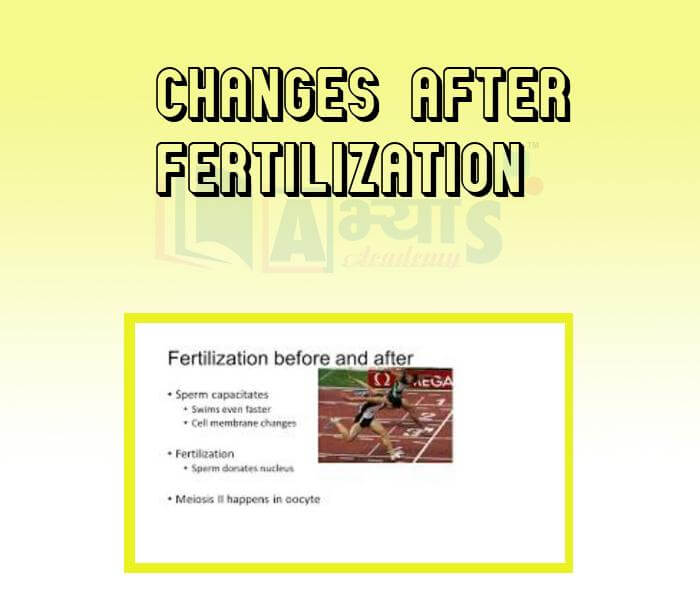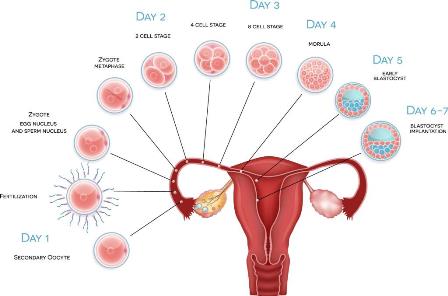Changes After Fertilization












Changes After Fertilization
Changes after Fertilization
Implantation: The fertilized egg (zygote) moves down the Fallopian tube and continuously undergoes cell division. Thus it forms a hollow ball of cells, called embryo. The embryo gets embedded in the wall of the uterus, which is thick and has muscles, glands and a large number of blood capillaries. This process is called implantation.
Pregnancy: The developing embryo at first derives nourishment directly from the mother’s blood flowing in the vessels lining the uterine wall. In about three weeks, it starts absorbing food and oxygen through an organ called placenta. The placenta is a disc like organ in the lining of the uterine wall. It has numerous villi, which are in direct contact with the mother’s blood flowing in the uterine wall. These villi provide a large surface area for glucose and oxygen to pass from the mother to the embryo and for wastes produced by the embryo to be passed into the mother’s blood. The embryo is connected to the placenta by a tube called the umbilical cord. By eight weeks, the embryo starts showing human features and is referred to as foetus. The total period of embryonic development, from the time of fertilization to birth, is called gestation period. It is around 280 days, or 9 months, in humans.
Birth: The wall of the uterus develops a thick layer of muscles during pregnancy. At the time of birth, the uterine muscles contract rhythmically and powerfully, causing labour pains to the mother. Finally, the baby is expelled by the contraction of the uterine muscles. This is called birth or parturition.
What happens when the egg is not fertilized: If the ovum is not fertilized in the upper part of the oviduct, it keeps on descending and is finally passed out through the vagina. It remains in the body for about 24 - 72 hours. As an egg is released for fertilization every month, the uterus also prepares itself every month for the implantation of a fertilized egg. The uterus becomes thick-walled and spongy in order to nourish the embryo. If no fertilization takes place, the thick uterine wall is no longer needed. So, it gradually begins to shrink. This shrinkage ruptures its blood vessels. As a result, blood and mucus ooze out of the vagina. This period, which lasts for 3—5 days, is called the menstrual period, and the process is called menstruation. If the ovum is fertilized, it gets implanted in the uterus wall and embryonic development starts. In this case, the uterus continues to develop in order to hold the embryo. And in this case, there is no question of its shrinkage resulting in menstruation.

Development of Embryo
The zygote (or fertilised egg) divides repeatedly to make a ball of hundreds of cells. This is called an embryo. The embryo moves down the oviduct into the uterus. The embryo gets embedded in the soft and thick lining of the uterus (see Figure 8). This is called implantation. When the embryo settles down in the uterus, the woman is said to have become pregnant (or said to have conceived). The embryo starts growing into a baby. The embryo gets food and oxygen from the blood vessels in the lining of the uterus. The cells of embryo begins to form specialised groups that develop into different tissues and organs of the baby. Embryo is an early stage in a developing baby. Thus, an unborn baby at an early stage of development in the uterus is called an embryo. The body features of the unborn baby are not much developed at the embryo stage. The unborn baby remains an embryo in the first eight weeks of pregnancy. A human embryo at 4 to 5 week's development is shown in Figure 9. We cannot identify any body features (hands, legs, head, eyes and ears, etc.) of the developing baby in this embryo.

The embryo continues to grow and develop in the uterus to form a baby. The embryo gradually develops body parts such as hands, legs, head, eyes and ears, etc. An unborn baby in the uterus at the stage when all the body parts can be identified, is called a foetus (The word 'foctus' is pronounced as 'fetus'). A human embryo becomes a foetus after about eight weeks of pregnancy. From about eight weeks until birth, the unborn baby is called foetus (see Figure 10). It takes about 38 weeks (about nine months) from the fertilisation of egg to. the formation of fully developed development of the foetus into a baby is complete, the mother gives birth to the baby. The fully formed baby comes out of the mother's body through vagina. And we say that a baby is born. This is how humans reproduce by giving birth to babies. All of us were born in this way.
Settling down of blastocyst on uterine wall is called ______________________ | |||
| Right Option : A | |||
| View Explanation | |||
Number of cells present in egg is __________________ | |||
| Right Option : A | |||
| View Explanation | |||
Connection between developing embryo and placenta is called ______________________ | |||
| Right Option : A | |||
| View Explanation | |||
Students / Parents Reviews [10]
Being a parent, I saw my daughter improvement in her studies by seeing a good result in all day to day compititive exam TMO, NSO, IEO etc and as well as studies. I have got a fruitful result from my daughter.

Prisha Gupta
8thMy experience with Abhyas is very good. I have learnt many things here like vedic maths and reasoning also. Teachers here first take our doubts and then there are assignments to verify our weak points.

Shivam Rana
7thAbout Abhyas metholodology the teachers are very nice and hardworking toward students.The Centre Head Mrs Anu Sethi is also a brilliant teacher.Abhyas has taught me how to overcome problems and has always taken my doubts and suppoeted me.

Shreya Shrivastava
8thIt has a great methodology. Students here can get analysis to their test quickly.We can learn easily through PPTs and the testing methods are good. We know that where we have to practice

Barkha Arora
10thI have spent a wonderful time in Abhyas academy. It has made my reasoning more apt, English more stronger and Maths an interesting subject for me. It has given me a habbit of self studying

Yatharthi Sharma
10thIt was a good experience with Abhyas Academy. I even faced problems in starting but slowly and steadily overcomed. Especially reasoning classes helped me a lot.

Cheshta
10thIt was good as the experience because as we had come here we had been improved in a such envirnment created here.Extra is taught which is beneficial for future.

Eshan Arora
8thMy experience was very good with Abhyas academy. I am studying here from 6th class and I am satisfied by its results in my life. I improved a lot here ahead of school syllabus.

Ayan Ghosh
8thMy experience with Abhyas academy is very good. I did not think that my every subject coming here will be so strong. The main thing is that the online tests had made me learn here more things.

Hiya Gupta
8thA marvelous experience with Abhyas. I am glad to share that my ward has achieved more than enough at the Ambala ABHYAS centre. Years have passed on and more and more he has gained. May the centre flourish and develop day by day by the grace of God.
